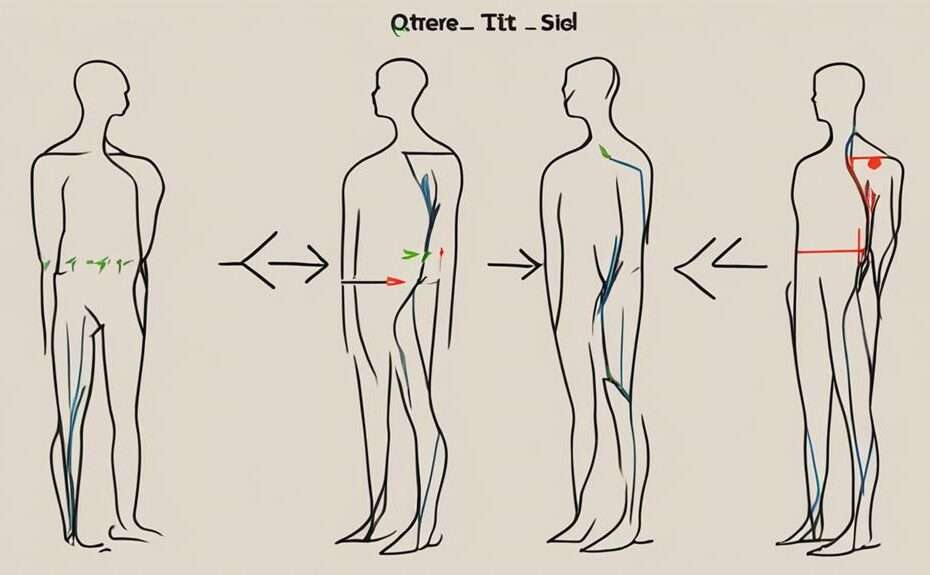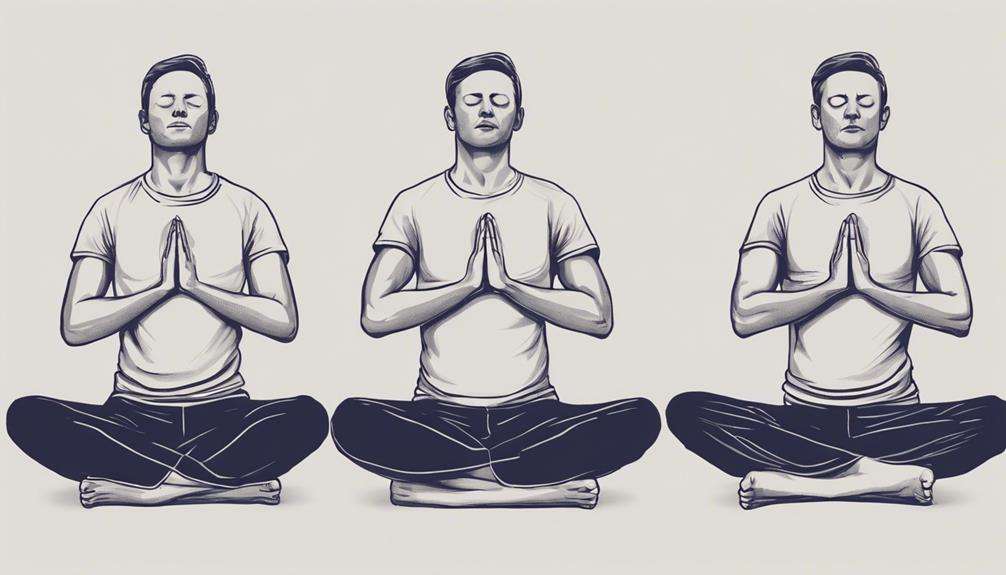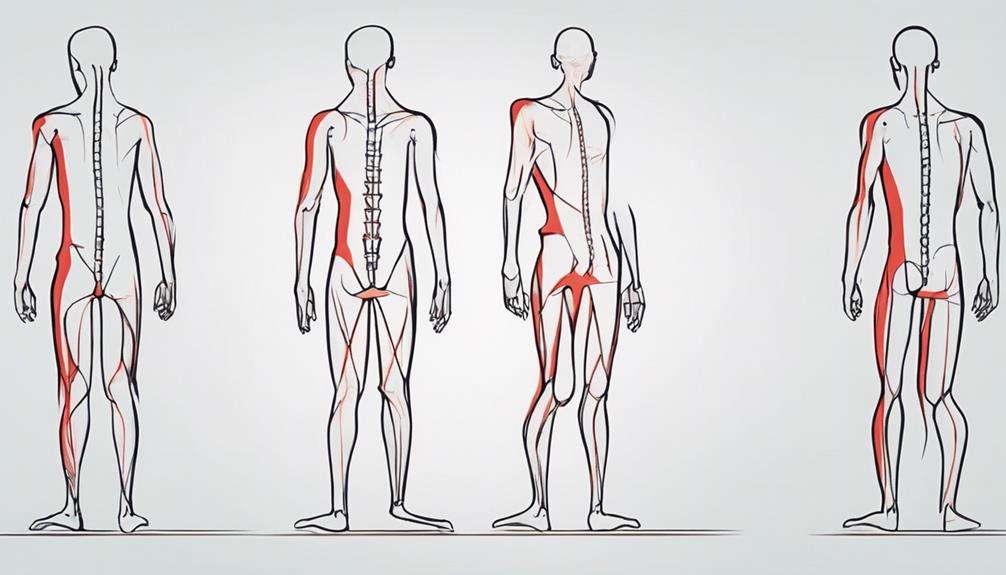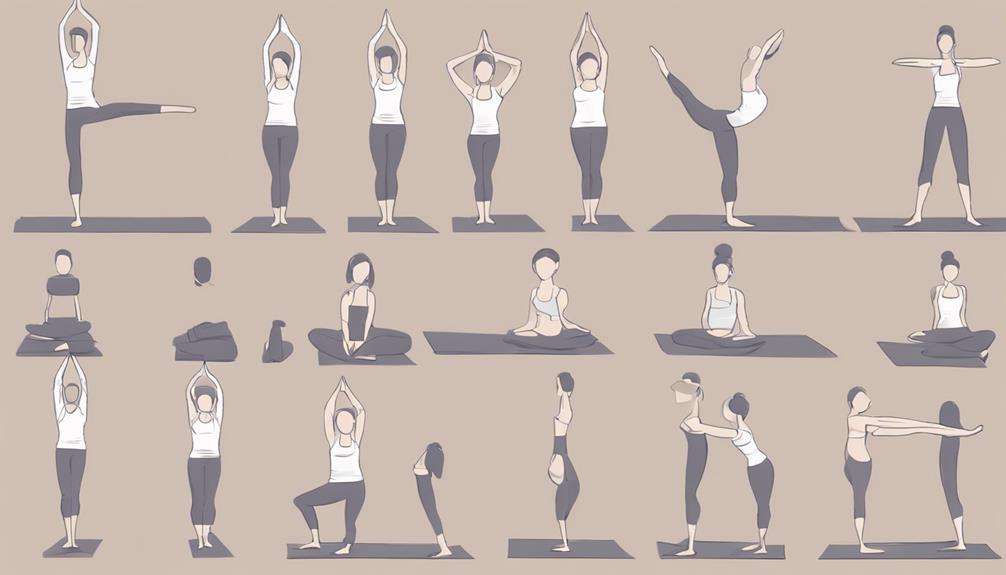When it comes to your posture, ensuring correct alignment of your pelvis is essential. Not only does it impact the way your spine functions, but it also influences the strength and flexibility of key muscles in your core and hips.
By addressing pelvic tilt, you are not just improving your posture but also taking a significant step towards enhancing your overall physical well-being. However, the benefits of correcting this alignment issue go beyond just physical appearance; they extend to your daily comfort and long-term health.
Key Takeaways
- Correcting pelvic tilt ensures proper alignment, spine support, and weight distribution.
- It prevents postural imbalances, alleviates lower back pain, and enhances overall health.
- Muscle imbalances from pelvic tilt can lead to back pain and mobility issues.
- Yoga, core strengthening, and stretching exercises play a key role in correcting pelvic tilt posture.
Understanding Pelvic Tilt Posture
Understanding pelvic tilt posture is essential for maintaining proper alignment and preventing potential musculoskeletal issues. The pelvis plays a vital role in supporting the spine and connecting the upper and lower body. Correct pelvic alignment guarantees that the weight of the body is evenly distributed, reducing strain on the lower back. When the pelvis isn't properly aligned, it can lead to postural imbalances, affecting movement patterns and overall body stability.
Addressing pelvic tilt posture isn't just about aesthetics; it also has significant implications for athletic performance and injury risks. Proper pelvic alignment allows for efficient energy transfer during physical activities, enhancing performance and reducing the likelihood of injuries. Moreover, maintaining the best pelvic posture can positively impact your quality of life by minimizing discomfort and enhancing overall well-being.
Effects of Incorrect Pelvic Alignment
Having incorrect pelvic alignment can greatly impact your spine, leading to abnormal lower back curvature and discomfort.
It can weaken your abdominal muscles, affecting core stability and overall posture, potentially causing a stomach bulge.
Muscle imbalances and strain due to pelvic tilt may also result in nonspecific pain in the groin region.
Impact on Spine
Incorrect pelvic alignment greatly impacts the spine by causing abnormal curvature in the lower back, leading to various discomforts and potential health issues. The exaggerated inward curve in the lower back, known as lordosis of the lumbar spine, can result in lower back pain and muscle tension. This misalignment can weaken the abdominal muscles, affecting core strength and stability.
Additionally, incorrect pelvic tilt may lead to strained hip muscles and pain in the hip joints, impacting mobility and daily activities. Over time, this misalignment can also contribute to overstretched hamstring muscles, increasing the risk of hamstring sprains and affecting lower body function and flexibility.
Correcting pelvic alignment is essential to alleviate these issues and promote overall spine alignment and health.
Muscle Imbalances
Muscle imbalances resulting from incorrect pelvic alignment can greatly impact your posture and overall musculoskeletal health. When your muscles are imbalanced, it can lead to issues like increased pelvic tilt and lumbar spine hyperlordosis.
Sedentary work can weaken pelvic erector muscles, while a lack of balance can shorten pelvic tilting muscles, worsening postural deficits. Imbalances in muscle activation may result in an anterior pelvic tilt, affecting pelvic alignment and contributing to back pain.
To address these issues, corrective exercises focusing on hyperactive and hypoactive muscles are essential. Strengthening, stretching, and body awareness exercises are key in correcting pelvic tilt posture and restoring proper muscle balance.
Prioritizing these exercises can help you improve your alignment and reduce the risk of musculoskeletal problems.
Pain and Discomfort
Experiencing pain and discomfort due to improper pelvic alignment can greatly impact your daily activities and overall well-being. Incorrect alignment can lead to lordosis, causing back pain and discomfort. This misalignment may result in a stomach bulge, weakening abdominal muscles, affecting core stability and posture.
Groin pain may surface due to muscle imbalances and strain caused by pelvic misalignment. Hip joint pain can impede mobility and functional movement. Compensatory mechanisms from incorrect pelvic alignment can lead to overstretched hamstrings, increasing the risk of hamstring sprains and impacting lower body function.
Addressing pelvic alignment is essential to alleviate these pains and avoid further complications in your body's musculoskeletal system.
Importance of Correcting Pelvic Tilt
Addressing pelvic tilt is important for your well-being, as it can alleviate lower back pain, prevent injuries, and enhance your overall health. By correcting pelvic alignment, you improve your posture, leading to better spinal alignment and reduced strain on your back muscles.
Embracing proper pelvic tilt not only supports your athletic performance but also enhances your mobility and core stability.
Posture Alignment Benefits
Improving your posture alignment by correcting pelvic tilt can greatly enhance your overall well-being and physical health. Addressing issues like anterior pelvic tilt or posterior pelvic tilting can alleviate lower back pain by reducing strain on the spine and promoting proper muscle function.
Enhanced posture alignment not only supports the spine but also benefits the muscles around the hips, leading to improved stability and coordination. Engaging in targeted exercises to correct pelvic tilt helps in realigning your posture, which positively impacts joint health and overall muscle function.
Pain Reduction Potential
Embracing proper pelvic alignment through corrective exercises is key to revealing the potential for reducing discomfort and enhancing your overall well-being. Correcting pelvic tilt plays an important role in addressing issues like lower back pain and promoting better spinal alignment, especially in the lumbar spine.
By focusing on posture correction to improve pelvic tilt, you can alleviate strain on the lower back, leading to decreased discomfort and improved functional movement. Additionally, this adjustment not only aids in preventing chronic pain conditions but also enhances musculoskeletal health and optimizes biomechanical efficiency.
Prioritizing spinal alignment through pelvic tilt correction is a proactive approach to fostering better overall health and well-being.
Improved Overall Health
For a healthier and more balanced body, correcting pelvic tilt posture is essential. Addressing pelvic tilt not only alleviates lower back pain and improves spinal alignment but also enhances ideal core stability, reducing strain on surrounding muscles.
By rectifying pelvic tilt, you can prevent muscular imbalances and associated postural deficits, leading to better overall posture and decreased injury risks. Ideal pelvic alignment supports efficient movement patterns, translating to improved athletic performance.
Embracing proper pelvic tilt posture is a pivotal step towards promoting your overall health and well-being. Make the commitment to correct your pelvic tilt for a stronger, more aligned body that moves efficiently, reducing the risk of injury and enhancing your performance in various physical activities.
Yoga Poses for Pelvic Tilt Correction
To correct pelvic tilt, incorporating specific yoga poses into your routine can greatly improve muscle strength and flexibility. Yoga poses such as Cat-Cow, Child's Pose, and Pigeon Pose are beneficial for stretching and strengthening muscles involved in pelvic tilt correction. These poses target areas like the hip flexors and core muscles, essential for addressing both anterior and posterior pelvic tilt.
Downward Facing Dog and Bridge Pose help enhance flexibility and stability in the pelvis and lower back. Cobra Pose and Warrior I pose focus on hip flexors and core strength, aiding in pelvic alignment. Additionally, poses like Tree Pose and Triangle Pose work on balance and posture, supporting the correction of pelvic tilt.
Regular practice of these yoga poses promotes body awareness, proper pelvic alignment, and muscle balance, all of which are pivotal for rectifying pelvic tilt issues. Incorporating these stretching and strengthening exercises into your routine can make a significant difference in addressing pelvic tilt and improving overall posture.
Strengthening Core for Better Alignment

Strengthen your core muscles to achieve better alignment and support for your spine and pelvis, ultimately improving your overall posture and reducing the risk of injuries.
Core strength plays a critical role in enhancing the stability of your spine and pelvis, which can alleviate the strain on your lower back. By focusing on core stability, you can promote a more ideal pelvic alignment, countering the impact of muscle imbalances that contribute to pelvic tilt.
Targeted exercises aimed at strengthening your core not only help correct muscle weaknesses but also support the best pelvic alignment. This improved core stability doesn't just benefit your posture; it can also enhance your athletic performance and functional movement patterns by ensuring proper pelvic positioning.
Investing time and effort in building your core strength is key to maintaining a healthy spine, aligned pelvis, and overall better posture.
Stretching Exercises for Pelvic Tilt
Enhance your pelvic alignment and improve posture through targeted stretching exercises designed to address pelvic tilt. Addressing an important tilt is vital, and stretching exercises like the Half-Kneeling Hip Flexor Stretch can help. By stepping one leg forward and holding the stretch for 30 seconds, you can reduce tightness in your hip flexors, promoting better pelvic alignment.
This not only improves flexibility but also relieves tension in the hip flexor muscles, which can contribute to lower back pain. Another beneficial stretch is the Kneeling Leg Lift with Back Stretch, which targets abdominal and gluteus muscles while maintaining a neutral back position.
These stretching exercises are essential for targeting key muscle groups involved in correcting important pelvic tilt, ultimately aiding in posture improvement. Incorporating these stretches into your daily routine can make a significant difference in achieving a more aligned and pain-free pelvic position.
Mindfulness and Posture Awareness
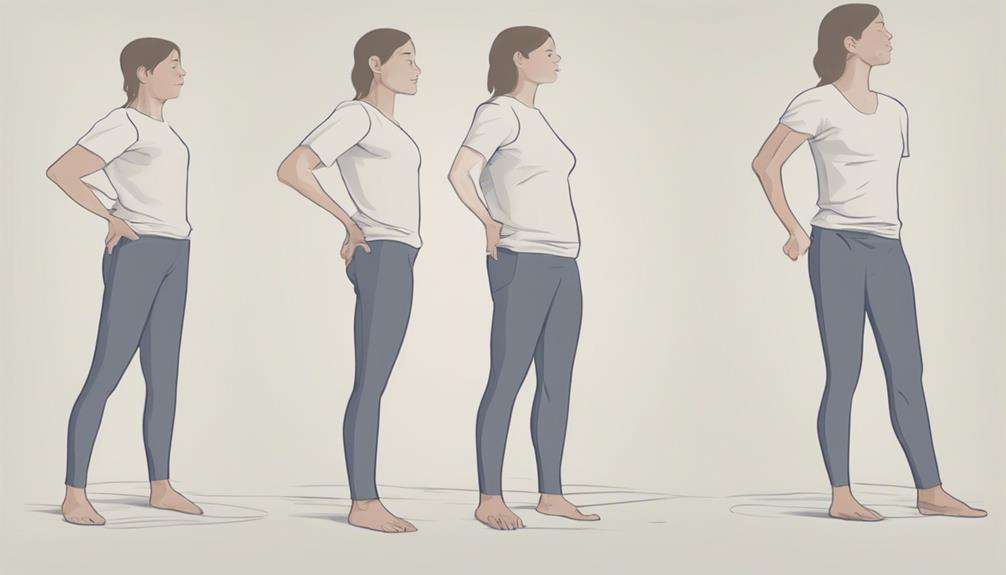
Improving your posture awareness through mindfulness practices can have a significant impact on correcting pelvic tilt and promoting overall musculoskeletal health. Mindfulness practices increase your awareness of posture by focusing on body alignment and muscle engagement, essential elements in correcting pelvic tilt.
By promoting proper spinal alignment and muscle balance, posture awareness techniques directly address the root causes of pelvic tilt issues. Engaging in mindful breathing exercises further aids in reducing muscle tension related to pelvic tilt, enhancing your body awareness and control.
The mind-body connection fostered by mindfulness practices not only improves postural control but also reduces the risk of musculoskeletal problems. By incorporating mindfulness into your daily routine, you can prevent postural imbalances and support your overall well-being through better posture.
Make mindfulness and posture awareness a priority to take proactive steps towards correcting pelvic tilt and maintaining the best musculoskeletal health.
Long-Term Benefits of Proper Alignment
For long-term benefits in maintaining proper alignment, focusing on ideal pelvic tilt is essential. By correcting pelvic tilt posture, you can greatly reduce the risk of low back pain and prevent chronic back pain issues. Improving pelvic alignment not only enhances posture but also contributes to better overall body alignment, promoting balance and stability in daily activities.
Over time, addressing pelvic tilt can prevent musculoskeletal imbalances and postural deviations, supporting your physical well-being in the long run. Perfect pelvic alignment plays a vital role in supporting organ positioning, which in turn enhances organ function and promotes better digestion and overall health.
Additionally, the aesthetic benefits of improved posture resulting from proper pelvic tilt can boost your confidence and present a more poised appearance. Embracing and maintaining neutral pelvic tilt alignment is a proactive step towards achieving lasting health benefits and ensuring a balanced and stable body structure.
Frequently Asked Questions
Why Are Pelvic Tilt Exercises Important?
To maintain healthy posture and prevent back pain, it's vital to focus on pelvic tilt exercises. Strengthen your core, improve spine alignment, and enhance pelvic stability. These exercises also boost hip flexibility, correct muscle imbalances, and support a consistent exercise routine.
What Is the Clinical Importance of Pelvic Tilt?
To optimize musculoskeletal health, managing pelvic tilt is key. Correcting posture enhances spinal alignment, restores balance, and prevents injuries. Strengthening your core through tailored exercises improves functional movement, reduces pain, boosts performance, and enhances overall well-being.
How Does Pelvic Tilt Affect Posture?
When your pelvic tilt affects posture, it impacts alignment, muscle balance, and can lead to lower back pain. Improving hip mobility, core strength, and spinal curvature through stretching exercises is important for stability and functional movement.
What Happens if You Don't Fix Anterior Pelvic Tilt?
If you don't fix anterior pelvic tilt, lower back pain, hip tightness, and poor posture may persist. Muscle imbalances can lead to knee problems, limited mobility, and chronic discomfort. Correcting tilt enhances performance and reduces risks.
Conclusion
To sum up, correcting pelvic tilt posture is crucial for overall health and well-being. By addressing this issue through targeted exercises and mindfulness, you can improve alignment, strengthen muscles, and reduce pain.
Remember, 'A journey of a thousand miles begins with a single step.' Take the first step towards better posture today for a healthier and happier tomorrow. Your body will thank you for it.
